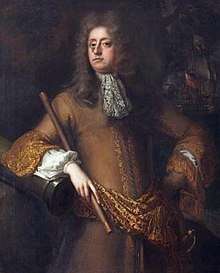Arthur Herbert, 1st Earl of Torrington
Admiral Arthur Herbert, 1st Earl of Torrington (c. 1648 – 13 April 1716) was an English admiral and politician. Dismissed by King James II in 1688 for refusing to vote to repeal the Test Act, which prevented Roman Catholics from holding public office, he brought the Invitation to William to the Prince of Orange at The Hague, disguised as a simple sailor. As a reward he was made commander of William's invasion fleet which landed at Torbay in Devon on 5 November 1688 thus initiating the Glorious Revolution.
Arthur Herbert, 1st Earl of Torrington | |
|---|---|
 Arthur Herbert, 1st Earl of Torrington, portrait by John Closterman | |
| Born | c.1648 |
| Died | 13 April 1716 (aged 67–68)[1] |
| Buried | |
| Allegiance | |
| Service/ | |
| Years of service | 1663–1690 |
| Rank | Admiral |
| Commands held | HMS Pembroke HMS Constant Warwick HMS Dragon HMS Dreadnought HMS Cambridge HMS Rupert |
| Battles/wars | Second Anglo-Dutch War Franco-Dutch War Nine Years' War |
Early life
Born the son of Sir Edward Herbert and Margaret Smith, daughter of Thomas Smith, Herbert joined the Royal Navy in 1663.[2] He was appointed a lieutenant in the third-rate HMS Defiance and saw action at the St. James's Day Battle in July 1666 during the Second Anglo-Dutch War.[2] Promoted to post-captain in 1666, he was given command of the fifth-rate HMS Pembroke in April 1667, of the fourth-rate HMS Constant Warwick in September 1668 and of the fourth-rate HMS Dragon in May 1672.[3] He went on to be captain of the third-rate HMS Dreadnought in spring 1672 and commanded her at the Battle of Solebay in May 1672 during the Franco-Dutch War.[2] After that he took command of the third-rate HMS Cambridge in October 1673 and was severely injured while commanding her at the Battle of Schooneveld in June 1673.[3] He commissioned the third-rate HMS Rupert in February 1678 and then commanded a squadron tasked with defending Tangier from the Moors in December 1679.[2]
Flag officer

Herbert was appointed Rear-admiral of England in 1683 and Master of the Robes in 1685.[2] These employments brought him in £4,000 a year.[2] However, when King James II required him to promise that he would vote for the repeal of the Test Act, which prevented Roman Catholics from holding public office, his answer was "that his honour and conscience would not permit him to give any such pledge". The King replied: "Nobody doubts your honour, but a man who lives as you do ought not to talk about his conscience". To this reproach (which came from a bad grace from the lover of Catherine Sedley) Herbert manfully replied: "I have my faults, sir; but I could name people who talk much more about conscience than I am in the habit of doing, and yet lead lives as loose as mine."[4] The King immediately dismissed him from all his offices.[2]
Herbert went to Holland in June 1688, carrying the Invitation to William, and offered his services to the Prince of Orange at The Hague.[2] The Prince appointed him commander-in-chief of the fleet which would take him to England.[2] Following the Glorious Revolution, Herbert became Lord High Admiral and then, when the post of Lord High Admiral had been put into commission, he became First Lord of the Admiralty and Senior Naval Lord[5] on the Board of Admiralty in March 1689.[6] He was raised to the peerage by the new King William III as Earl of Torrington and Baron Herbert of Torbay in May 1689,[7] following on his command of the English squadron at the Battle of Bantry Bay. He was credited with being the first to use the expression, "fleet in being". He proposed avoiding a set battle, except under very favourable conditions, until the arrival of reinforcements: by maintaining his fleet in being, he would force the French to remain in the area and prevent them from undertaking other operations.[8]
Herbert commanded the English and Dutch fleets at the Battle of Beachy Head in July 1690, a serious defeat for the allied fleet, in the Nine Years' War.[2] He was imprisoned in the Tower of London and was court-martialed for failing to support the Dutch van squadron against the French, but was acquitted. Nevertheless, he lost his position as First Lord of the Admiralty, and took no further part in public life. The stories that Torrington was not a popular commander, because of his reputation of being a drunk and his habit of taking several prostitutes with him to sea, have been discredited.[9][10] In 1696 he acquired Oatlands Park, an estate forfeited by his brother, Sir Edward Herbert, who had followed King James II into exile.[11] He died on 13 April 1716 without children, rendering his titles extinct,[2] and was buried in Westminster Abbey.[12]
Marriages
Torrington married twice, but had no issue by either wife:[13]
- Firstly to Anne Hadley, from whom he later separated;
- Secondly to the twice widowed Anne (dowager Lady Crew), daughter and co-heiress of Sir William Airmine, 2nd Baronet.
References
- Edward Wedlake Brayley; Mantell (1850). A topographical history of Surrey: the geological section by Gedeon Mantell. G. Willis. p. 383.
- Laughton, John Knox (1891). . In Lee, Sidney (ed.). Dictionary of National Biography. 26. London: Smith, Elder & Co.
- "Arthur Herbert". Three Decks. Retrieved 5 August 2017.
- Macaulay, Thomas Babington (1848). The History of England from the Accession of James the Second. Porter & Coates.
- Rodger, p. 34
- "Sainty, JC, Lord High Admiral and Commissioners of the Admiralty 1660–1870, Office-Holders in Modern Britain: Volume 4: Admiralty Officials 1660–1870 (1975), pp. 18–31". Archived from the original on 7 October 2014. Retrieved 4 September 2009.
- "No. 2458". The London Gazette. 3 June 1689. p. 2.
- Maltby, p. 160
- van Gent, p. 90
- Le Fevre, pp. 19–42
- "Herbert, Arthur (c.1648–1716), of Oatlands Park, Weybridge, Surrey". History of Parliament. Retrieved 7 August 2017.
- "Arthur Herbert, 1st Earl of Torrington". Westminster Abbey. Retrieved 7 August 2017.
- "Arthur Herbert, 1st Earl of Torrington". Cracroft's Peerage. Retrieved 5 August 2017.
Sources
- Chisholm, Hugh, ed. (1911). . Encyclopædia Britannica. 27 (11th ed.). Cambridge University Press.
- Hattendorf, John B. "Herbert, Arthur, earl of Torrington (1648–1716)". Oxford Dictionary of National Biography (online ed.). Oxford University Press. doi:10.1093/ref:odnb/13017. (Subscription or UK public library membership required.)
- Laughton, John Knox (1891). . In Lee, Sidney (ed.). Dictionary of National Biography. 26. London: Smith, Elder & Co.
- Le Fevre, Peter (2000). "Arthur Herbert Earl of Torrington". Precursors of Nelson: British Admirals of the Eighteenth Century. Stackpole Books. pp. 19–42. ISBN 978-0-8117-2901-7.
- Maltby, William S (1994). "The Origins of a global strategy: England from 1558 to 1713". In Williamson Murray; et al. (eds.). The making of strategy: rulers, states, and war. Cambridge, England: Cambridge University Press. ISBN 978-0-521-56627-8.CS1 maint: ref=harv (link)
- Rodger, N.A.M. (1979). The Admiralty. Offices of State. Lavenham: T. Dalton Ltd. ISBN 0900963948.
- van Gent, T. (2000). 17 Zeventiende Eeuwse Admiralen en hun Zeeslagen (in Dutch). Den Haag: Koninklijke Vereniging van Marineofficieren. p. 90. ISBN 9789090136585.
- Burke's Extinct Peerages: TORRINGTON, E
| Parliament of England | ||
|---|---|---|
| Preceded by William Stokes Thomas Papillon |
Member of Parliament for Dover 1685–1689 With: William Chapman |
Succeeded by Sir Basil Dixwell Thomas Papillon |
| Preceded by Bernard Granville The Earl of Ranelagh |
Member of Parliament for Plymouth 1689 With: Sir John Maynard |
Succeeded by Sir John Maynard The Hon. John Granville |
| Court offices | ||
| Preceded by The Hon. Henry Sydney |
Master of the Robes 1685–1687 |
Succeeded by Lord Thomas Howard |
| Military offices | ||
| Preceded by Sir William Clifton |
Colonel of Arthur Herbert's Regiment of Foot 1686–1687 |
Succeeded by The Hon. Sackville Tufton |
| Preceded by King William III |
Lord High Admiral 1689 |
Succeeded by In commission |
| Preceded by Himself (Lord High Admiral) |
First Lord of the Admiralty 1689–1690 |
Succeeded by The Earl of Pembroke |
| Preceded by New Post |
Senior Naval Lord 1689–1690 |
Succeeded by Sir John Chicheley |
| New regiment | Colonel of the 1st Maritime Regiment 1690 |
Succeeded by Earl of Danby |
| Peerage of England | ||
| New creation | Earl of Torrington 1689–1716 |
Extinct |
.svg.png)